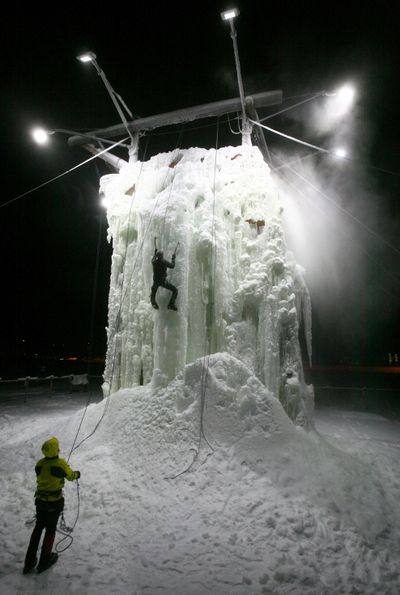University of Alaska opens ice climbing tower

FAIRBANKS, Alaska – The University of Alaska Fairbanks’ ice climbing tower has opened for its second winter and the ice-making operation has gone smoother this year than it did last, both in terms of quality of ice and the production process.
“The ice has formed up to resemble more what a real waterfall would be; it’s more vertical this year,” said Sam Braband, outdoor facilities manager for UAF’s Department of Recreation, Adventure and Wellness.
Climbers got their first whack at this year’s ice when part of the wall opened the first week of this month.
Last year, the first the wall was in operation, the ice featured a multitude of “cauliflowers,” big, lumpy, clumps of ice that resemble giant, frozen versions of the vegetable. While cauliflowers may look cool, they don’t offer the challenge climbers are looking for because they are much easier to get an ice axe into, Braband said.
“It looks cool and it’s kind of fun, but if you’re going down Fox (Creek) or Dragonfly (Creek) it’s not going to be like that,” he said.
This year, workers knocked most of the cauliflowers off before they could form in an attempt to keep the ice more vertical, Braband said.
The opening for the ice tower is later this year than last because of warm weather in October and early November that prevented staff from making ice. When it finally did get cold enough to start making ice in the second week of November, Mother Nature tossed another curve ball in the form of a storm that featured freezing rain and above-freezing temperatures. The rain and warm weather may actually have helped make for better ice, though, Braband said.
“It didn’t really damage the ice we had up there,” he said. “It might have made it a little bit better. It kind of melted away the cauliflowers and stuff.”
More ice still needs to be built on the east and west sides of the wall, but the back side of the tower has a full complement of ice for climbers to dig into, Braband said.
“It’s definitely gone smoother,” Braband said of the ice-making operation this year compared to last year. “It’s not perfect yet, but it’s coming along.
The neighboring Nanook Terrain Park, meanwhile, still needs more snow before it can open, said Eric Ofelt, who is in charge of making the jumps and installing the rails for skiers and snowboarders on the hill below the Butrovich Building.
“We’ve got a solid 3-inch base and we need a 6-inch base to get the netting in,” Ofelt said of the netting that surrounds the terrain park. “Once we get the netting up around the perimeter we’ll start doing work on the jumps.”
There still isn’t enough snow to do much in the way of building jumps, Ofelt said. Once more snow does fall, though, groomers will have an easier time pushing it around this year thanks to a new Bombardier BR 275 snowcat that UAF purchased this summer from a company in Utah. Even with the little bit of snow that has fallen this winter, groomers were able to use the snowcat to push and pack snow.
“It’s already made grooming the hill a pleasure,” he said, comparing it to the snow machines and drags workers used last year. “It’s cut our time by probably 400 percent.”